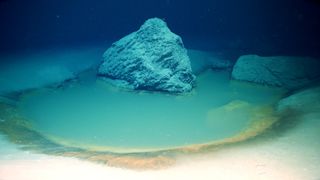Charles Q. Choi writes:
Rare deep-sea brine pools discovered in the Red Sea may hold clues to environmental upheavals in the region that span millennia, and could even shed light on the origins of life on Earth, a new study finds.
Deep-sea brine pools are extraordinarily salty or “hypersaline” lakes that form on the seafloor. They are among the most extreme environments on Earth, yet despite their exotic chemistry and complete lack of oxygen, these rare pools teem with life and may offer insights on how life on Earth began — and how life could evolve and thrive on water-rich worlds other than our own.

“Our current understanding is that life originated on Earth in the deep sea, almost certainly in anoxic — without oxygen — conditions,” study lead author Sam Purkis, a professor and chair of the Department of Marine Geosciences at the University of Miami, told Live Science. “Deep-sea brine pools are a great analog for the early Earth and, despite being devoid of oxygen and hypersaline, are teeming with a rich community of so-called ‘extremophile’ microbes. Studying this community hence allows a glimpse into the sort of conditions where life first appeared on our planet, and might guide the search for life on other ‘water worlds’ in our solar system and beyond.”
Note: The relevance of extremophiles for the origin of life has been addressed in the past. Here is a quote from an Astrobiology article cited in a blog at Reasons.org: “Their point was that as intractable as a naturalistic explanation for mesophilic life is, naturalistic explanations of extremophilic life are orders of magnitude more intractable.”
Scientists know of just a few dozen deep-sea brine pools in the entire world, which range in size from a few thousand square feet to about a square mile (2.6 square kilometers). Only three bodies of water are known to host deep-sea brine pools: the Gulf of Mexico, the Mediterranean Sea and the Red Sea.
Using a remotely operated underwater vehicle (ROV), the scientists discovered the pools 1.1 miles (1.77 km) beneath the surface of the Red Sea…
“At this great depth, there is ordinarily not much life on the seabed,” Purkis said. “However, the brine pools are a rich oasis of life. Thick carpets of microbes support a diverse suite of animals.”
Most interesting among those “were the fish, shrimp and eels that appear to use the brine to hunt,” Purkis said. The brine is devoid of oxygen, so “any animal that strays into the brine is immediately stunned or killed,” he explained. The predators that lurk near the brine “feed on the unlucky,” he noted.
What happens in a brine pool, stays in a brine pool
Because the brine lacks oxygen, the pool keeps out the usual animals that live in and on the seabed, such as burrowing shrimp, worms and mollusks. “Ordinarily, these animals bioturbate or churn up the seabed, disturbing the sediments that accumulate there,” Purkis said. “Not so with the brine pools. Here, any sedimentary layers that settle to the bed of the brine pool remain exquisitely intact.”
Core samples that the researchers extracted from the newfound brine pools “represent an unbroken record of past rainfall in the region, stretching back more than 1,000 years, plus records of earthquakes and tsunami,” Purkis said.
Complete article at Live Science.